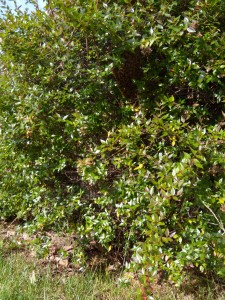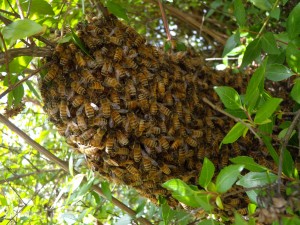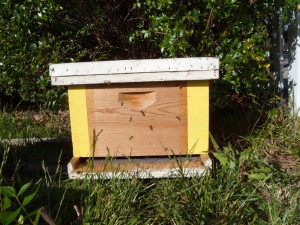Death
Earlier this week the city cut down an old Valley oak in our neighborhood. It’s a tree I walked past as a child and one that I have always loved. Turns out it was well over 350 years old. I know, of course, that there are plenty of species that live far longer than this, but somehow I can’t get over the fact that a tree in the place I call home grew up in the 1600s, that it shaped this landscape even as the land around it went from open oak savannah to suburban lawns and asphalt.
Lawns and asphalt, incidentally, are probably what compromised its health to the point that, even with all its vibrant spring growth, the city felt the need to limit liability and cut it down.
Kelly and I sat on the curb under its leaning trunk and talked to it in our hearts the night before it died. We went back the next afternoon and touched the great, oozing rounds of it that the city left behind. And we pulled out soft white sponges of oak root fungus (Armillaria mellea) from the tree’s core and smelled the yeasty sweetness.
We are lucky. There are probably dozens of giant old Valley oaks in our immediate neighborhood. They are stunning and majestic, and they are holy to me. Most of them are planted in the middle of irrigated lawns, or crowded next to sidewalks and driveways. There aren’t many young trees, at least not ones that will have space to grow.
I have watched the Valley oaks slowly going over the course of my small human life, taken out by the city or falling on their own. It has always nagged at me that there is no longer space in this suburban landscape for Valley oaks to thrive and reproduce.
But there’s something about losing the tree this week that has lit a fire in me and broken my heart, all at once. Maybe I will nag the city to start replanting trees from local stock. Maybe I’ll go door to door imploring neighbors to stop irrigating lawns at the bases of these drought resistant trees, to take out paving, to make space.
Death
The second death this week is also heartbreaking. Kelly and I went outside today and noticed that no bees were flying into Mondo, our beloved three-year-old top-bar hive. We got underneath and looked up through the screened bottom with a headlamp. There were a handful of zippy, agitated bees, but no group in sight, no rumbling hum of a healthy hive.
As usual, Mondo built up beautifully this spring. They swarmed at least once last month. All we can figure is that their new virgin queen got lost on her mating flight.
Of course, we could always be wrong. Perhaps they swarmed a few more times when we weren’t looking and are still waiting for the new queen to get up and running. But it doesn’t look good, and we’re fairly certain they’re gone.
We have other great bees, but Mondo’s line was our favorite and our longest-lived survivors. To make matters worse, Juniper, Mondo’s first swarm from last year, is our only other hive from this lineage, and she isn’t looking great. Although she built up well coming out of winter, we’re not aware of Juniper swarming yet, and she seemed to slow way down in March. There is a pile of dead bees in front of Juniper that we think have deformed wing virus.
Birth
About an hour after discovering Mondo’s troubles, we got a call from some friends who live just two blocks away. They reported that there was a swarm in their front yard, and asked if we wanted it. We jogged over in our bee suits, and there it was: a beautiful, mellow, good-sized swarm about three feet off the ground in a shrub.
This never happens to us.
We are used to swarms high up in trees on perilous branches. We’re used to swarms with eight queens and thousands of worker bees that can’t figure out where their allegiance lies. We’re certainly not used to swarms that march docilely into a box that you place just below them.
Even Kelly, who has sworn off beekeeping with all of its stresses and unpredictability, was excited about this swarm. We wondered whether there’s a little bit of Mondo’s genetics in these bees, or if they came from the cavity in the old Valley oak that stands next to the one that was cut down. We wondered if they are exactly what our hearts need.





5 Responses to Birth and Death